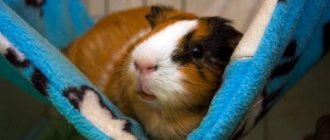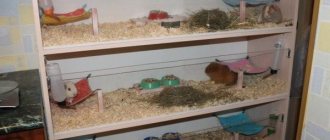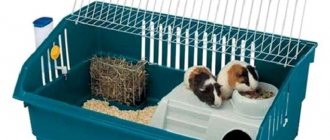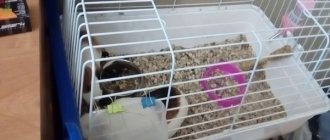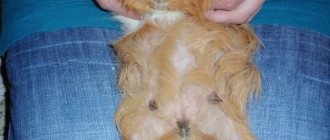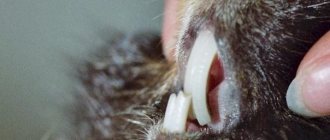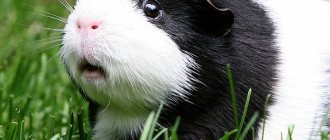Contrary to prevailing stereotypes, guinea pigs are very different from other rodents (for example, hamsters) both in character and lifestyle. Therefore, housing for these animals must be arranged in accordance with their needs.
Let's find out which cages are suitable for guinea pigs and how to properly equip them, and step-by-step instructions for creating a house for a rodent with your own hands will help you with this.
Material of manufacture
The catalog of cages for animals presents different options, but many are not even worth considering. A bad material for keeping a guinea pig is wood. Although such cells look beautiful, they absorb dirt and odors. The rodent happily sharpens its teeth on wooden beams, destroying the cage.
Often in a pet store they try to force a terrarium or an aquarium on the buyer. The main argument is that dirt and sawdust will not fly into the room. But in such containers there is no ventilation. The animal will breathe fumes from excrement. In addition, the guinea pig’s brain is designed in such a way that the animal does not see what is happening behind the glass, and in such a house it will feel lonely.
Popular sections:
Aquariums Sale of kittens and puppies Terrariums Products for cats Products for dogs
The optimal composition of the cage is a plastic tray and metal rods.
Such houses are durable, resistant to moisture, easy to wash and do not collapse under the influence of disinfectants.
Popular manufacturers
Pet stores sell devices from different manufacturers. They are designed to suit a specific budget and needs.
Popular designs for pigs are the product of the Russian company Triol. The company offers a wide range of accessories and household items for small rodents. The devices are of high quality; stainless steel grilles are covered with enamel. Some models are equipped with a lattice bottom for better ventilation. Such a cage for a guinea pig costs from 1,500 to 5,000 rubles.
The Italian company Ferplast produces wooden, metal and plastic housing. The structure is made in the form of a wooden base with lattice walls, or a lattice top with a plastic tray. The bars of the grill are coated with a mixture that protects the grill from your pet's sharp teeth. Models of such designs are equipped with shelves, ramps, and additional trays for the street. The cages of this company have folding door-walls, which makes cleaning easier.
ferplast cages are equipped with additional accessories necessary for a pet to live a comfortable life.
The price of such a home ranges from 3 to 5 thousand rubles. Convenience and comfort are more important than the price of a cage in which the pet will feel great.
The Midwest company produces housing for pigs that is more similar in design to enclosures than to cages. A canvas bottom is attached to the lattice walls and roof below. This design is easy to clean, has a spacious area and includes partitions and ramps.
The design of sections allows you to transform the enclosure for outdoor keeping; you can also connect several structures together and create a large enclosure.
The cost of the enclosure is about 6,000 rubles.
Belgian dune and cage manufacturer savic offers convenient cages with hinged doors. This makes it convenient to take out your pet and clean the tray and interior items.
Manufacturers of Italian imac cages offer comfortable designs made from quality materials. The structure is made of plastic. The interior of the home is equipped with a shelf and a ramp. There are doors in both the walls and the roof. The cost of such a device is from 4 to 9 thousand rubles.
The number of options for ready-made designs for pigs provides a lot of possibilities. But you can also make a cage yourself. This will allow you to take into account the specific conditions of keeping the animal and the possibilities of the premises.
The cost of a guinea pig cage may be lower if you buy the device secondhand. Often, housing for a pet is given away along with the pet when the previous owner is allergic to wool. You can find very cheap cages on pet owner forums and websites selling used items.
Design
An important point when choosing a cage for a pet is the correct design. You cannot take a cage for birds, hamsters, ferrets or any other pets. Such structures are dangerous for a guinea pig because they are too high and do not have a clear division into floors, and the pet can get injured in them. Remember other useful tips:
- The safe height for the animal is 10-15 centimeters; objects and accessories cannot be placed above this mark.
- Choose houses of rectangular or square shape (the main thing is large width).
- The removable cage cover makes cleaning easy.
- If you have several pets or plan to breed them, choose cages with dividing panels and ramps.
- If you travel frequently, buy a crate that can be disassembled and assembled so you can take your pet with you.
Guinea pig cage size
Pigs are very active animals. They need to exercise a lot to maintain good physical shape. Therefore, large cages are suitable for them. City apartments may not always allow for a large space for a pet. Veterinarians recommend setting aside at least one square meter of space for each pet. It is also necessary to take into account the height of the “ceilings” in the rodent’s home; the height of the walls must be at least 40 centimeters so that the animal can stand on its hind legs.
If the size of the living space does not allow you to provide the required size of housing for the rodent, then you can get by with a small cage in which the pig will rest at night. During the day, the animal is released into a specially fenced and prepared space so that it can run around to its heart’s content. At the same time, the animal must have access to food, water and a sleeping place.
If you have a summer house in the summer, it will be useful for the animal to spend time in the fresh air. Owners set up enclosures in their summer cottages and let their pets out to frolic on the grass.
Filler
Filling is placed in the pet's cage, otherwise the animal is at risk of fungus, various types of dermatitis, hair loss and other health problems. This is a necessary part also for the following reasons:
- the animal's paws are adapted to soft surfaces;
- the filler plays the role of a toilet;
- the pig needs to dig and dig for something.
Experts recommend different beddings, each of which has its own advantages and disadvantages.
| Type | pros | Minuses |
| Wood sawdust | They absorb moisture well, soft, inexpensive. | Almost do not absorb odors, often cause allergies |
| PVC mat | Pleasant soft surface, with it the food will lie separately from the filler | Not used separately, there must be filler underneath. There is a risk of poisoning from the substances from which the mat is made. |
| Toilet paper | Sold in any store, soft, does not cause allergies | Impractical, instantly saturated with odor and moisture |
| Absorbent diapers | Convenient to use | Dear ones, they get dirty quickly |
| Hay or straw | Natural natural material | Your guinea pig will quickly eat this stuffing. |
| Fleece | In demand among pig breeders in Europe, it is warm, stays dry for a long time, can be washed and used many times | Also not used separately, only complete with filler. |
Whatever you use, keep in mind that the main rule is that the filler should be as natural as possible, without dyes or toxic additives.
Where to place the cage
To create conditions for a comfortable life, a pig needs a certain temperature regime, the absence of cold air flows, close proximity to heating devices and sunlight. Heating and air conditioning should not be located closer than half a meter from the pet's cage.
In the room where the pet lives, the air temperature is set at 18 to 20 degrees, humidity – 50%.
The pet’s home should not be placed close to the wall; a distance of 30 centimeters should be left.
Pigs are quite shy animals; constant loud noises can cause them stress. Frequent stress leads to depression. Therefore, the animal must live in a place where there is no TV, loud barking dogs and other noise stimuli.
In addition, the room should be bright, with good air circulation. It is recommended to regularly ventilate this room, but do not allow your pet to be exposed to a draft. To do this, the pet and its housing are placed higher, on a table or on a rack, or taken to another room for ventilation.
The pig's home should not be placed in a room with freshly painted walls, cooking smells, a smoking room or a room adjacent to it, since strong odors are also uncomfortable for the pigs. The room in which the animal will live should be bright, but direct rays should not fall directly on the pet’s home. Since the animal quickly overheats. This is harmful to his health.
Food
A healthy diet will prolong the life and improve the health of your pet. Remember the correct diet of the animal:
- hay – 60%;
- vegetable and fruit components, greens – 30%;
- dry food – 10%.
The main product on the animal’s menu is hay. It forms healthy digestion for your pet and supplies it with all the necessary substances and vitamins. The most useful is considered to be hay made from cereals and beans, clover, alfalfa, and nettle. Hay is purchased or prepared independently.
Guinea pigs are primarily herbivores, so the menu should include seasonal fruits and vegetables. Pieces that are not eaten before the next feeding are thrown away. Your pet's daily diet should include at least 5 types of vegetables and herbs. The animal is offered sprouted grains and seeds, branches of trees and shrubs along with leaves and flowers (acacia, birch, maple, poplar). Remember that many plants, such as lilacs, and most indoor flowers are poisonous to guinea pigs.
Setting up a guinea pig cage
If the pet’s home is small, then the necessary minimum of “furniture” is installed in it: a drinking bowl, a feeding trough, a hay barn, a tray, a house. Animals love space and to run around, so you shouldn’t clutter up a small space with unnecessary accessories. If the space allows you to place additional accessories and entertainment, then this will not hurt the animal. These include stairs, shelves, houses, labyrinths. It must be remembered that all these elements must be safe for the animal.
To save space, it is better to purchase drinking bowls and hay bars that are attached from the outside. There are models with retractable feeders. If the feeder is placed inside the cage, it is better to choose heavy ceramic models with a wide bottom or containers that can be attached to the grid to avoid tipping over.
It is recommended to choose a house with two openings for entry and exit to make it more comfortable for the animal. Also, for ease of cleaning, the house should be chosen without a floor. A holiday home with a flat roof will function as a shelf if a safe ramp is connected to the roof.
Proper arrangement of the cage will ensure a comfortable life for the animal, and will also allow the owner to easily restore order in the house.
Be sure to add filler to the bottom. It must be changed regularly to prevent moisture from accumulating at the bottom and to prevent the growth of unwanted bacteria.
A large number of types of housing for rodents in pet stores allows you to choose the most convenient for a particular case. If you need a completely unusual option, then you can make such a design yourself. In any case, it is necessary to proceed from the requirements of keeping a pet so that it lives a long and happy life.
Toys
Interesting toys will delight your guinea pig. But owners must remember what items are prohibited from being placed in a rodent’s cage:
- running wheels;
- walking balls;
- rings and bells on ropes.
Guinea pigs are slow and inflexible animals; they have weak spinal muscles. The following items can cause serious injury. Tunnels are great for stimulating physical activity. A good choice would be tennis or ping-pong balls, cubes, and any high-quality toys for leisure and grinding down the rodent's teeth.
How to make it yourself
A homemade cage has a number of advantages:
- Use of environmentally friendly materials.
- Less money is spent on consumables.
- The design and dimensions of the device are suitable for the individual parameters of the room in which the pet will live.
Recommended dimensions for the base on the short side are 70 cm, on the long side 100 cm. For two pets, the long side should be at least 140 cm, for three – 170 cm, for four – 210 cm. The height of the roof should be at least 40 cm.
To make a cage you will need:
- Knife;
- cardboard;
- a simple pencil;
- ruler;
- lattice;
- scotch;
- screeds.
Production begins with markings on straightened cardboard. A base with the required parameters is drawn on it, leaving an additional 15 centimeters on each side. Using a knife, make shallow cuts along the lines of the drawing. Then the cardboard is covered with tape, gluing the strips tightly to each other or overlapping. Then the sides are raised at the cardboard base, which must be secured with tape.
The pre-prepared lattice is cut according to the parameters of the base and assembled, fastened with ties. The resulting structure is inserted into a cardboard base. Housing is ready.
It is recommended to choose the width of the grille gap at 2.5 centimeters. This will allow the paws not to get stuck, but it is also impossible for the animal to crawl through such a gap.
It is recommended to equip your guinea pig's cage with partitions, shelves and other devices for entertaining the animal. Shelves and ramps must be made of wood. Stoppers need to be attached to the edges of these elements so that the pet understands where the surface ends.
Aviaries and summer paddocks
Most often, a guinea pig enclosure is an apartment. It is around the apartment that the animal runs around, studying the surrounding objects, climbing into a variety of places and causing a lot of trouble for the owner. Some animals get stuck in cracks between furniture, manage to get tangled in wires, or get underfoot. The animals are very active and it can be difficult to keep track of their movements.
To protect the animal, you can equip it with a special enclosure or pen in the room, or even better, on the balcony.
If the balcony is insulated, then the animal can walk there in winter. It’s good to install several labyrinths and holes in the pen, hang hammocks, lay out toys and don’t forget to hang some mangers for hay or grass. The running animal will want to eat. If the breeder has a summer house and spends the whole summer there, then you can set up a summer pen for the guinea pig in the open air. This will be very useful for the animal, but you should follow some rules. First and most important, the enclosure must have reliable shelter from any bad weather and be inaccessible to any other animals and birds. There must be several houses for pigs in the pen. If they are installed at different heights, it is necessary to take care of the safety and convenience of ladders for animals.
A summer pen can be made from mesh, but it is better to use the shape of a wooden box with one or two sides made of mesh with a mesh of no more than three centimeters. This design protects from bad weather, predators, and drafts. You cannot install the pen directly on the ground - it is better to use a special stand or legs. This will avoid dampness, cold and infection by many parasites. The size of the summer pen is most often several times larger than the size of the cage. For one animal, a pen with dimensions of 150 by 200 cm is suitable. A large area will allow the pig to move a lot and not feel lonely even when the owner is busy with his dacha affairs. The summer paddock should be equipped with several feeders and drinkers, one or two houses, labyrinths and toys.
Soft lounger
Your little furry friend will definitely love a small round bed in the form of a blanket bed with low sides on which you can rest your head. It looks incredibly cute, but whether the pig will sleep in it is a separate question. On the other hand, it will definitely decorate the cage, so buying goods on Aliexpress will not be completely useless.
Material: cashmere and cotton.
Dimensions:
- S (diameter 14 cm on the outside and 8 cm on the inside),
- L (diameter 22 cm on the outside and 15 cm on the inside).
Colors: coffee, blue, light and dark pink, camel.
Price: 83.35 to 96.66 rubles (depending on size).
Delivery is free.
